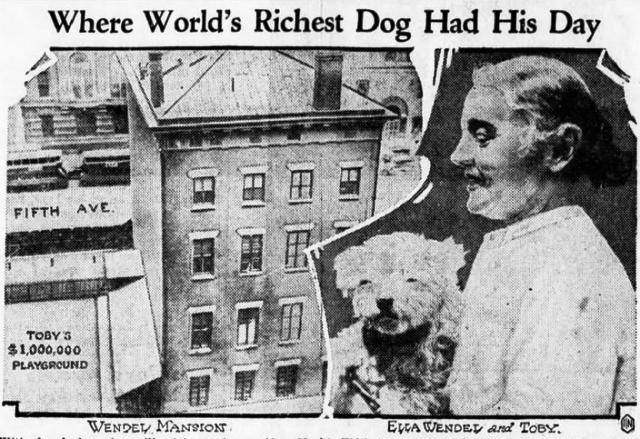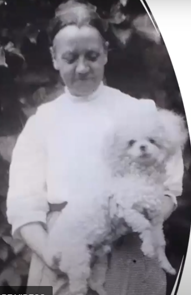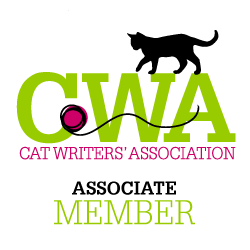
Many years ago, I wrote about Toby Wendel, the French poodle who lived in the old Wendel mansion on Fifth Avenue and 39th Street. I recently came across this story about a Christmas dinner for the dog, while doing some extra research about the Wendel family for an upcoming presentation.
According to legend, when New York City multi-millionaire Ella Wendel passed away in her mansion at 442 Fifth Avenue in 1931, she left her entire estate – valued at about $50 million or more — to her French poodle, Toby. Although this turned out to be false (Ella bequeathed her inheritance to many charities), the story of the Wendel family is extraordinary.
I am not going to repeat the entire story of the Wendels here–you can click above to read it–but I am going to share a story about Toby’s last Christmas before he passed away in 1933. I’ll also provide some additional history about the land where the Wendel mansion was built in 1856.

In 1856, John Daniel Wendel built a red brick mansion on the northwest corner of Fifth Avenue and 39th Street. John’s father, John Gottlieb Wendel, an associate and in-law of John J. Astor, had earned a fortune, first in the fur trade and then in buying and leasing large chunks of Manhattan real estate.

John Daniel Wendel and his wife Mary Ann had eight children born from 1835 to 1853: Johann, or John Gottlieb Wendel Jr., Henrietta Dorothea, Mary Elizabeth Astor, Rebecca Antoinette Dew, Augusta Antonia Stansbury, Josephine Jane Steinbeck, Georgiana Geisse Reid, and Ella Virginia von Etchzel.
Over the years, all of the family members died, leaving the youngest daughter, Ella, alone in the large old home with only a few servants and her dog, Toby, to keep her company. (She also reportedly had a few cats, but I cannot find any reliable record of these pets.)
Every night, Ella would let her dog play in the million-dollar, walled-in yard on the side of the house. The poodle also had his own miniature four-poster bed and a butler to wait on him as he dined.


The Toby in this Christmas tale was not the first Toby Wendel. In fact, the family had many dogs, all of whom were buried in the Wendel’s pet cemetery at their summer home in Irvington, New York.
The first white poodle named Toby joined the family in 1911; the Toby in this story arrived sometime around 1928, when Rebecca, Georgiana, and Ella were all still alive.
On March 13, 1931, Ella Wendel died in her sleep in the home at the age of 78. Only about 19 “friends” and one distant relative — Stanley Shirk, the nephew of her deceased brother-in-law — attended the services at at her home. Toby also attended the services.
A large crowd of people gathered in front of the Wendel house as her casket was carried out, hoping to get a glimpse inside the mysterious old Wendel mansion. Other than one or two doctors and a family friend, no one outside the Wendel family had ever set foot in the house once John Daniel Wendel had passed away.

Following Ella’s passing, Toby’s life took a turn for the worse. With no special butler left to care for him, Toby was made to sleep in a plain basket in the kitchen and to eat his food like any ordinary dog from a saucer. At night he’d wander inconsolably through the dark, empty house looking for his mistress.
Ella Wendel’s will was hotly contested (some said Ella was not of sound mind when she prepared her will, because if she had been ok, she would have added a provision for the care of her dog), and more than 2,000 people falsely claimed to be related to the wealthy Wendels. Eventually, though, most of the Wendel estate went to various charities and organizations, including Drew University, which now owned the $5 million mansion.

In December 1931, with the estate not yet settled, Toby was still living in the house. The three remaining servants in the Wendel mansion served Toby a meal of calves’ liver on a special little doggie table in the dining room.
All the furnishings and antiques in the house were sold at auction in September 1933. One month later, a veterinarian was called in to put Toby humanely to sleep. At the age of 8, he had become overweight and often snapped at people.
Toby was buried on the grounds of the Wendel summer estate in Irvington, alongside the graves of all the other Tobys and other dogs that came before him.
A Brief History of Fifth Avenue and 39th Street

The Wendel family in America dates back to John Gottlieb Matthias Wendel, a German fur trader who arrived in New York in 1798. He married Elizabeth Astor, a half-sister of John Jacob Astor. The two men went into the fur business together at a small shop on Maiden Lane.
The fur trade was profitable, and soon Astor and Wendel started buying up New York real estate. Their motto was, never take out a mortgage, never sell, and keep moving north. In time, unbeknown to most people, the Wendels became Manhattan’s land-richest family.
John and Elizabeth’s son, John Daniel Wendel, continued in his father’s footsteps. When Elizabeth Astor Wendel died on November 28, 1846, she left her son a vast amount of Manhattan real estate. The younger Wendel never sold any of it.
In 1856, John Daniel Wendel moved from his home at 705 Broadway and ventured north into the rural suburbs to build a red brick mansion on the northwest corner of Fifth Avenue and 39th Street.
This land had once been part of Bloomingdale, which encompassed several square miles along the Hudson River from 42nd to 129th Streets, give or take. More specially, this little corner of Manhattan was once a farm owned by a Scottish auctioneer and merchant named John Taylor.

Taylor and his wife, Margaret Scott, arrived in the New World from Glasgow in the spring of 1785. The family lived downtown in a “cozy dwelling” above Taylor’s shop at 225 Queen Street (183-185 Pearl Street).

By 1796, the family had seven children (one other child had died very young), and another baby was on the way. That year, Taylor purchased a tract of land in Bloomingdale from the estate of Dr. Samuel Nicoll (aka Nichol) for 1575 pounds. Although Margaret died only two weeks after giving birth to her last child, the large family continued to spend summers at the Bloomingdale farm until making it their fulltime home in 1811.
The large house with white columns faced the Bloomingdale Road (near today’s 6th Avenue and 38th Street), and had a back entrance on what was called the Middle Road. The 10-acres farm was surrounded by mature trees, and there was a garden where the family grew produce that they sold at the Fulton Market.
John Taylor died on June 30, 1833. None of his children wanted the old home at Bloomingdale, and so the property was sold in 1834 for a mere $50,000.





Thank you for sharing such an intriguing story! It’s fascinating to imagine what early New York must have been like—its streets, buildings, and the people (along with their furry family members) who lived here. Stories like yours truly bring this history to life!